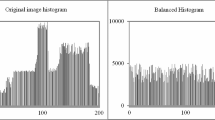Abstract
The visual plane of human–computer interaction has a great influence on the perception of color images. The author proposes the use of visual communication in the development and optimization of human–computer interface graphics. The local contrast of the plane vision image can be improved according to the relationship between the current and the pixel area, and the full description of the plane vision image in human–computer interaction is better. The maximum time taken to clarify image color using this system was 0.2 s less than the Binocular Vision Enhancement system and 0.18 s less than the Mark Visibility Enhancement system; When this system is used to enhance the color of the composite image, the maximum time consumption is 0.18 s, which is 0.37 s less than the binocular vision enhancement system. The system requires the shortest time and has the best performance for processing color images. The design improves the color accuracy of the image plane on the human–computer interaction page, and the processing speed is fast for processing simple and normal images and complex images.







Similar content being viewed by others
Data availability
The data used to support the findings of this study are available from the corresponding author upon request.
References
Kapgate D (2022) Efficient quadcopter flight control using hybrid SSVEP+ P300 visual brain computer interface. Int J Hum Comput Interaction 38(1):42–52
Li L (2021) Visual information enhancement method of multimedia human-computer interaction interface based on virtual reality technology. Int J Inf Commun Technol 19(2):127–142
Liu X, Pan H (2022) The path of film and television animation creation using virtual reality technology under the artificial intelligence. Sci Program 2022:1–8
Feng Z, Wu J, Ni T (2021) Research and application of multifeature gesture recognition in human-computer interaction based on virtual reality technology. Wirel Commun Mob Comput 2021:1–5
Ellis KK, Prinzel LJ III, Kiggins DK, Nicholas SN, Ballard K, Lake RC, Arthur TJ (2021) High-fidelity line operational simulation evaluation of synthetic vision flight deck technology for enhanced unusual attitude awareness and recovery. Int J Hum Comput Interact 37(7):642–654
Bai Y, Shao J, Zhang Y, Yao J, Tian F, Xue C (2022) Effects of different viewing angles and visual stimuli on the performance of MI brain-computer interfaces. Int J Hum Comput Interact 38(16):1–15
Chen X, Tang X, Zhao Y, Huang T, Qian R, Zhang J, Wei C, Wang X (2023) Evaluating visual consistency of icon usage in across-devices. Int J Hum Comput Interact 39(1):1–17
Rebensky S, Carroll M, Bennett W, Hu X (2022) Impact of heads-up displays on small unmanned aircraft system operator situation awareness and performance: a simulated study. Int J Hum Comput Interact 38(5):419–431
Patil BM, Burkpalli V (2021) A perspective view of cotton leaf image classification using machine learning algorithms using WEKA. Adv Hum Comput Interact 2021:1–15
De Paolis LT, Vite ST, Castañeda MÁP, Dominguez Velasco CF, Muscatello S, Hernández Valencia AF (2022) An augmented reality platform with hand gestures-based navigation for applications in image-guided surgery: prospective concept evaluation by surgeons. Int J Hum Comput Interact 38(2):131–143
Sultana S, Ahmed SI, Rzeszotarski JM (2021) Seeing in context: Traditional visual communication practices in rural Bangladesh. Proc ACM Hum Comput Interact 4(CSCW3):1–31
Liu Y, Sivaparthipan CB, Shankar A (2022) Human–computer interaction based visual feedback system for augmentative and alternative communication. Int J Speech Technol 25(2):305–314
Yun Y, Ma D, Yang M (2021) Human–computer interaction-based decision support system with applications in data mining. Futur Gener Comput Syst 114:285–289
Wang R (2021) Computer-aided interaction of visual communication technology and art in new media scenes. Comput Aided Des Appl 19(S3):75–84
Yin J, Yang JH (2021) Virtual reconstruction method of regional 3D image based on visual transmission effect. Complexity 2021:1–12
Seinfeld S, Feuchtner T, Maselli A, Müller J (2021) User representations in human-computer interaction. Hum Comput Interact 36(5–6):400–438
Prathiba T, Kumari RSS (2021) Content based video retrieval system based on multimodal feature grouping by KFCM clustering algorithm to promote human–computer interaction. J Ambient Intell Humaniz Comput 12:6215–6229
Taber L, Dominguez S, Whittaker S (2022) Cats, Kids, and video calls: how working from home affects media self-presentation. Hum Comput Interact 37(5):454–479
Kang J, Girouard A (2022) Impact of UX internships on human-computer interaction graduate students: a qualitative analysis of internship reports. ACM Trans Comput Educ (TOCE) 22(4):1–25
Liu W (2021) Research on the application of multimedia elements in visual communication art under the Internet background. Mob Inf Syst 2021:1–10
Author information
Authors and Affiliations
Corresponding author
Ethics declarations
Conflicts of interest
The authors declare no conflicts of interest.
Additional information
Publisher's note
Springer Nature remains neutral with regard to jurisdictional claims in published maps and institutional affiliations.
Rights and permissions
Springer Nature or its licensor (e.g. a society or other partner) holds exclusive rights to this article under a publishing agreement with the author(s) or other rightsholder(s); author self-archiving of the accepted manuscript version of this article is solely governed by the terms of such publishing agreement and applicable law.
About this article
Cite this article
Ma, K., Lee, S. & Chen, H. Application of Visual Communication in Image Enhancement and Optimization of Human–Computer Interface. Mobile Netw Appl (2023). https://doi.org/10.1007/s11036-023-02220-9
Accepted:
Published:
DOI: https://doi.org/10.1007/s11036-023-02220-9




